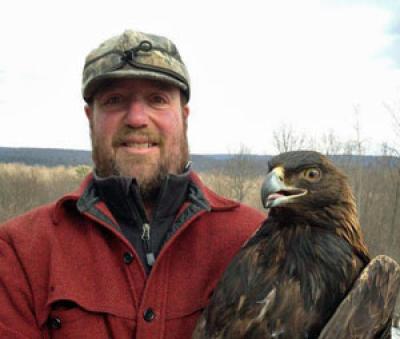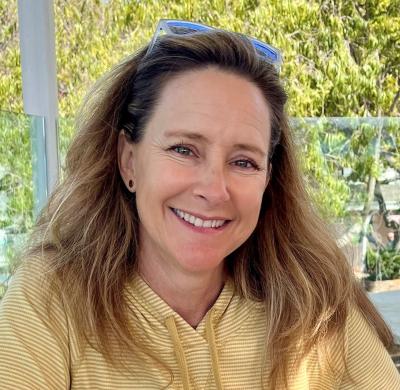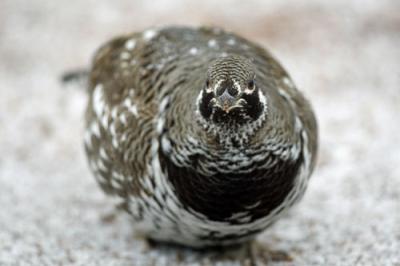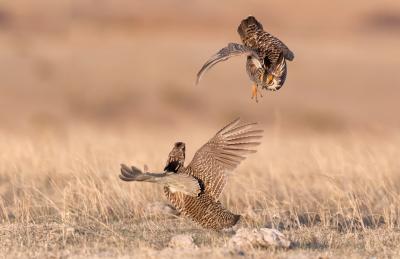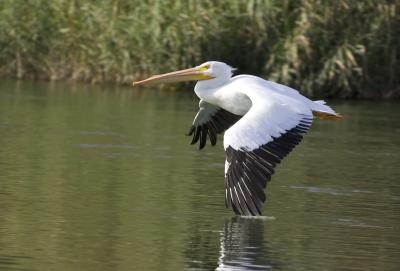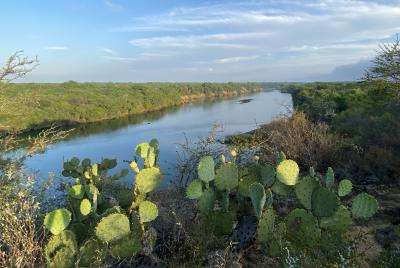Nebraska: The Sandhills and the Platte River
Sandhill Cranes and Prairie Chicken
-
Mar 11-16, 2026
Frank Nicoletti
2026
Single Room Supplement $450
2026
Single Room Supplement $450
As it crosses the plains of central Nebraska, the Platte River hosts one of North America’s greatest wildlife spectacles. Each spring, several million birds stop over on their northbound migration, among them more than 500,000 Sandhill Cranes, some 80 percent of the world population. Every evening and morning, the cranes in their thousands fly to and from feeding grounds in nearby fields and wet meadows and roosting areas on the Platte’s broad channels and sandbars. We’ll watch them both arriving and departing. During the day, Greater Prairie Chicken are a major focus and we’ll observe their manic dancing displays at a site in the 20,000 wild square miles of Nebraska Sandhills.
Other species regularly seen on our tour include Ross’s and Richardson’s Cackling Geese, Harlan’s Red-tailed Hawk, Baird’s Sandpiper, American Woodcock, Red-headed Woodpecker, Carolina Wren, Dark-eyed (Oregon) Junco, Harris’s Sparrow, and Eastern and Western Meadowlarks. Our relaxed schedule lets us appreciate fully the extraordinary concentrations of birds that make central Nebraska a world-class birding destination.
Day 1: The tour begins at 3:00 pm at our hotel in Carter Lake, Iowa, a short distance from Omaha’s airport. We’ll have an early dinner, then depart for nearby Lake Manawa where we hope for a variety of waterfowl, large numbers of gulls, in some years including Franklin’s and Lesser Black-backed, and the antic displays of American Woodcock. Night in Carter Lake.
Day 2: We’ll visit the upland and floodplain woodlands of Fontenelle Forest, a privately owned 1,600-acre remnant of eastern deciduous forest. Resident and wintering birds can include Red-headed and Pileated Woodpeckers, Winter Wren, Tufted Titmouse, ‘Red’ Fox Sparrow, and a number of other eastern species not likely elsewhere on our route. After lunch, we’ll drive around the area’s wetlands, hoping for waterfowl, shorebirds, and passerines including Harris’s and ‘Gambel’s’ White-crowned Sparrows. Night in Carter Lake.
Day 3: We’ll drive three-hours west to the central Platte River valley. At Grand Island, we’ll leave the interstate to drive Sandhill Crane-lined back roads in search of Bald Eagle, Baird’s Sandpiper, and American Tree Sparrow. Arriving in Kearney, we’ll have an early dinner and end the day on the banks of the Platte witnessing the amazing sight and sound of thousands of Sandhill Cranes flying to roost in the river’s shallows. Night in Kearney.
Day 4: We’ll leave pre-dawn for the south bank of the Platte where we’ll watch the cranes wake up and begin to pour out of their river roosts. We’ll return to Kearney for a late breakfast, then depart for the charming and historic town of McCook, situated on the flat Nebraska plains and next to the Republican River. We’ll arrive in McCook in the mid-late afternoon, check in to our hotel, and meet with our local guide and a Prairie Chicken biologist who can answer our questions about the Greater Prairie Chicken and chicken life. Attendance is required as visits to the lek are carefully controlled and our behaviors restricted. Night in McCook.
Day 5: This will be an early morning, but well worth it: we’ll leave with our local guide to visit the dancing grounds of Greater Prairie Chicken, viewing their amazing dance from behind specially made blinds. We’ll remain in our blind until the birds leave for their brunch, usually around 8:00 am, then return to McCook for our own hearty breakfast. Later, we’ll return to eastern Nebraska, a road trip which offers not only a chance to catch up on rest but as well stopping for a “missed” bird or two along the way. Night in Carter Lake.
Day 6: We may explore new areas, as well as revisit some of eastern Nebraska’s best hotspots, letting our choice be determined by any good birds discovered in our absence. A few days can make a big difference in late March, and we may find that Hermit Thrush, Eastern Phoebe, or other early migrants have arrived while we’ve been out west. We’ll return to Omaha’s Eppley Airfield around 11:30 am, where the tour concludes.
Note: The information presented below has been extracted from our formal General Information for this tour. It covers topics we feel potential registrants may wish to consider before booking space. The complete General Information for this tour will be sent to all tour registrants and of course supplemental information, if needed, is available from the WINGS office.
ENTERING THE UNITED STATES: Non-US citizens need a valid passport and may need a tourist visa. Consult your nearest US Embassy or consulate for details. Canadian citizens should carry proof of citizenship in the form of a passport.
PACE OF THE TOUR: Most of the tour takes place on level ground, with much of our birding on roads and wide trails. We will often be out in the field shortly after dawn, which sometimes requires a drive of 30 minutes or more. With the exceptions noted in the itinerary, we’ll eat breakfast before starting. Very early mornings will be followed by breakfast. Lunch will be at fast-food restaurants, sandwich shops or cafes. We will generally have a break before dinner to rest and clean up.
HEALTH: The Platte River region presents no real hazards to the visiting birdwatcher. Staying warm and dry in the changeable weather of an early Nebraska spring is the most important consideration.
Smoking: Smoking is prohibited in the vehicles or when the group is gathered for meals, checklists, etc. If you are sharing a room with a nonsmoker, please do not smoke in the room. If you smoke in the field, do so well away and downwind from the group If any location where the group is gathered has a stricter policy than the WINGS policy, that stricter policy will prevail.
Miscellaneous: Even in warm years, biting insects are scarce to non-existent at this season. Wood ticks, however, some of which carry Rocky Mountain spotted fever or other serious illnesses, may be present; they are best avoided by staying on paths and trails and out of tall grass.
CLIMATE: The Platte region in March experiences a wide range of weather conditions. It can be cold and windy, with temperatures in the 10- 20F range, but mild, sunny weather with readings from the 50s to 70s F is just as likely. Rain and snow are possible at any time, but rarely last more than a day at this time of year. Be prepared for cool to cold temperatures and wind, and be grateful when it turns out to be pleasant.
ACCOMMODATIONS: We will be staying at standard, comfortable motels with telephone,WiFi internet, and the usual amenities. Cell phone service can be elusive in the Sandhills.
FOOD: Our motel breakfasts are the standard modest buffets. Lunches will be at sandwich shops, cafes, or Runza Hut, Nebraska’s delicious contribution to the world of fast food. Our dinner destinations will include local restaurants and steakhouses.
Food Allergies / Requirements: We cannot guarantee that all food allergies can be accommodated at every destination. Participants with significant food allergies or special dietary requirements should bring appropriate foods with them for those times when their needs cannot be met. Announced meal times are always approximate depending on how the day unfolds. Participants who need to eat according to a fixed schedule should bring supplemental food. Please contact the WINGS office if you have any questions.
TRANSPORTATION: We will be traveling by leader-driven 12- or 15-passenger window van or by minivan, depending on the size of the group. Participants will change seats each day and should be able to ride in any seat in the tour vehicle.
2025 Narrative
In Detail:
March 12: The tour began at 3:00 pm at our hotel in Carter Lake, Iowa, a short distance from Omaha’s airport. After doing introductions and talking over some of the general instructions for the tour, we ventured to nearby Lake Manawa where we had great views of a variety of waterfowl, 19 species in all plus some passerines which included our first looks at Harris Sparrow. We headed to dinner near by and then came back to Lake Manawa to view the antic displays of American Woodcock. We also watched a Great Horned Owl sitting and flying. We also had the opportunity to view these night birds, plus deer and raccoon through thermal night vison, which was new for many folks on the tour. Thanks to Dave Allen for bringing the night vision optic.
March 13: We started the first full day by visiting the upland and floodplain woodlands of Fontenelle Forest, a privately owned 1,600-acre remnant of eastern deciduous forest. Birds found included Red-shouldered Hawk, Tufted Titmouse, Carolina Wren, Golden-crowned Kinglets, Brown Creepers and Eastern Meadowlarks. Some of these were the only individuals recorded on the tour.
After lunch, we drove to Cunningham Marsh where we had good looks with great lighting on more waterfowl including our first Northern Pintail, a beautiful male. While in route to De Soto National Wildlife Refuge we picked up Wild Turkey and Turkey Vulture. The refuge was quiet but picked up our first sizable flock of Snow Geese, our only Rusty Blackbird of the trip, and watched Bald Eagles on the nest.
March 14: After an early breakfast, we headed west for Kearny. On the way we birded several locations. The first was Pawnee SRA. We managed 54 species in the SRA, which some highlights included Yellow-bellied Sapsucker, an adult male Merlin, a flock of 20 American Pipits, pair of Purple Finches, Yellow-headed Blackbird and Yellow-rumped Warbler. We picked up a few birds in route to Keystone Prairie Dog Town, but we got to watch 3 different Ferruginous Hawks, which was certainly a highlight, hunting over the vast Black-tailed Prairie Dog. We watched the prairie dogs giving alarm call when raptors were nearby. Out in the prairie area we found several types of Red-tailed Hawks, Greater Yellowlegs and Baird’s Sandpipers. We drove to Kearny seeing 1000's of Sandhill Cranes in the fields along with other birds including Snow and Ross’s Geese and other waterfowl.
We ended the day after dinner at the Rowe Sanctuary anticipating a large number of cranes going to roost on the Platte River. With stormy conditions and strong winds, dramatic skies and thunder and lightning in the background we estimated 200,000 Sandhill Cranes go to roost on the river. The volume of the swirling flocks and the vocalization of the cranes was deafening and we stood in awe of the magnificent event. Topping that we watched four Whooping Crane with their white coloration against the dark grey sky background for nearly 20 minutes as they navigated the winds before landing on the river.
March 15: With the previous nights spectacular crane event, we decided to go back to see the liftoff of the cranes. It did not disappoint us. We got a view of one of the Whooping Cranes among the estimated 170,000 Sandhill Cranes.
After watching the lift off we headed to Funk Federal WPA, unfortunately the strong winds from the cold front the night before made viewing difficult and we decided to revisit the area the next day. Although we didn't leave the WPA with out some highlights which included Prairie Falcon and Lapland Longspurs.
We arrived in the charming and historic town of McCook, situated on the flat Nebraska plains and next to the Republican River. Once checked into our rooms we went to our evening talk about the history and status of the Greater Prairie Chickens. Angus Garey, whose family owned and worked the ranch since the 1870’s was a great treat to listen too. He discovered the Lek in the 1960’s and continues to keep the land managed for the chickens. After a quick dinner, we opted to get to sleep early in anticipation of an early and exciting morning of chicken watching.
March 16: Carol Schlegel, Director of the Visitors Bureau picked us up at the hotel and drove us to the Lek site in the dark. While on the farm we watched a Short-eared Owl hunting over the prairie in the headlights of the van while making several close passes. Once in the blind and situated, we started to hear the calls of the Prairie Chickens coming toward the Lek site. The next two hours we sat and watched the spectacular dance of the chickens. Much like the crane spectacle, we sat in awe of the chicken display.
After a hardy breakfast at the hotel, we headed east again. However, before leaving McCook we stopped at the local town park where we had excellent views of Ross’s and White-fronted Geese.
We again headed for Funk Federal WPA and saw 30 species of birds. The days prior conditions had improved and viewing more enjoyable. We saw lots of waterfowl and were lucky enough to find a covey of 12 Northern Bobwhite and located the same flock of Longspurs.
On the way toward Kearny we saw 100,000 cranes, lots of Snow Geese and found our first Harlan’s Red-tailed Hawk of the trip. We saw another, both dark morphs, heading toward Carter Lake.
March 17: We ventured out again to Manawa Lake to see if we could pick up some new species and enjoy last looks of the spectacular view of waterfowl. We were able to add Trumpeter Swans and Swamp Sparrow to our list. Afterwards we travel to Omaha’s Eppley Airfield. It was tough to say good bye, as we all became friends and enjoyed some special moments on the tour.
Frank Nicoletti, 2024
Maximum group size seven with one leader.




























